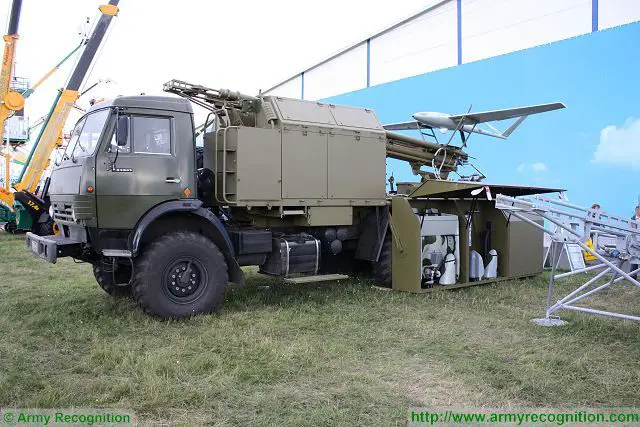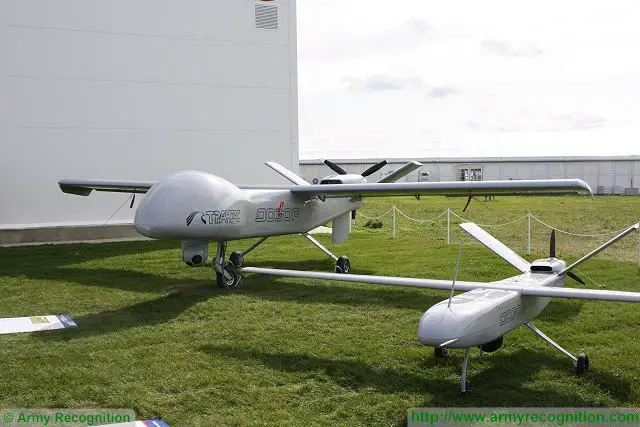Analysis Russia defense industry UAVs new development 10305172
|
|
|||
|
Military Defense Industry Technology - Russian UAVs industry
|
|||
|
|
|||
| Analysis Russian defense industry to boost the development of new UAV systems. | |||
|
Unmanned aviation is a dynamically developing industry of modern aircraft construction. Technical and technological achievements boosted the design of new systems. At present drones are engaged by many armies of the world and used in armed conflicts. Our country used to have considerable achievements in the sphere and now works to restore its positions, expert Denis Fedutinov writes in the official blog of the United Aircraft Corporation.
|
|||
|
|
|||
 Russian-made Tipchak UAV launcher station at MAKS 2009, AirShow near Moscow |
|||
|
|
|||
|
The former Soviet Union enjoyed a major experience in drone development also in the tactical class. Until recently the Russian army had old Strizh and Reis systems developed by the Tupolev Design Bureau yet in the 1970s and the Stroi-P complex with remote controlled Pchela craft designed by Kulon Research Institute and the Yakovlev bureau in late 1980s. Unfortunately, the economic plight of the transition period in the 1990s stalled the work. The initial pace was lost as a result, the designs got obsolete, the existing technical and scientific experience in the sphere was lost and the country began to considerably lag behind leading foreign producers.
The interest in drones revived in Russia in mid-2000s mostly due to the effort of private companies which initiated some steps to create mostly small-class craft. The Russian defense ministry kept displaying little interest in drones for some years. The guideline was however supported by law enforcement agencies - the interior ministry, the Federal Security Service (including the Border Service) and the emergencies ministry. In early and mid-2000s the orders of the defense ministry for the design of domestic drones were very modest. The latest system in the arsenal of the Russian military was tactical Stroi-P with remote controlled Pchela craft designed at the end of the Soviet epoch. In the 1990s the system became morally outdated. In early 2000s the Kulon Institute of the Vega Concern upgraded the complex to Stroi-PD version. The Rybinsk-based Luch Design Bureau of the Vega designed another tactical Tipchak craft. As in the case of Stroi-PD the funds were appropriated mostly for R&D. The Vega Concern and the defense ministry signed a contract for the delivery of one such complex a year which was an absolutely symbolic action. Problems caused by the absence of modern reconnaissance and surveillance drones were exposed by the 2008 situation in Abkhazia and South Ossetia. The defense ministry tried to engage available drones but none of them was capable of fulfilling the mission. The Russian troops were actually blinded. In contrast the Georgian military efficiently engaged the drones bought from the Israeli Elbit Systems Company. As for Stroi-PD, it took off with the use of powder boosters which exposed the launch site. The flight itself could not be stealthy because of the noisy two-stroke engine. |
|||
|
|
|||
 Russian UAVs from Dozor Company at MAKS 2009, AirShow near Moscow |
|||
|
|
|||
|
The Russian military also complained about the noisy Tipchak tactical drone designed by Vega. It was created in the Luch Design Bureau in Rybinsk. Former Russian Deputy Defense Minister Vladimir Popovkin said the drone was engaged in the operation in South Ossetia and performed poorly. Besides noise problems, the quality of reconnaissance data was low because of the line TV camera which failed to produce images corresponding to modern requirements. Besides, there were also problems with friend-or-foe system.
The developments around the conflict with Georgia became the threshold which made the Russian defense ministry urgently take measures to rectify the stagnant situation with modern drones for the national armed forces. Initially foreign designs were purchased, as well as available systems of domestic companies. R&D to create perspective craft was launched. The first step was the purchase of drones from Israel which is the world leader in the sphere and then an additional batch of drones was assembled in Russia. Plans to buy Israeli drones were first voiced in November 2008 by General Chief-of-Staff Nikolai Makarov. As a result, the defense ministry acquired short-range Bird-Eye 400 and medium-range Searcher Mk II of the Israeli Aerospace Industries (IAI). According to the contract signed in 2011, the drones were assembled in Russia by the UZGA Works in Yekaterinburg under Zastava and Forpost brands correspondingly. Major modernization and localization of tactical Forpost production is being considered. The drone is to get some domestically-produced systems, including a secured communications line and state system of identification, as well as GLONASS-based navigational system, radio-technical reconnaissance and data transmission devices, digital aerial survey system and lateral visibility radar |
|||


























